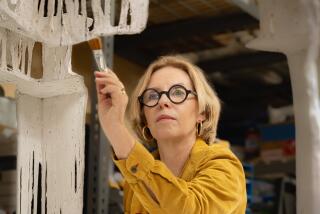‘Conversations With Frank Gehry’ by Barbara Isenberg
Conversations With
Frank Gehry
Barbara Isenberg
Alfred A. Knopf: 352 pp., $40
My hopes, I’ll admit, were not especially high for “Conversations With Frank Gehry,” Barbara Isenberg’s collection of recent interviews with the architect. Particularly in public, Gehry can be reticent, even uncomfortable, when discussing the ideas behind his buildings. Though there are certainly architects -- Rem Koolhaas, Robert Venturi, Elizabeth Diller and Peter Eisenman among them -- who use the process of talking and writing as a kind of design software, shaping concepts that show up later in their work, Gehry is not one of them.
But a couple of things make “Conversations With Frank Gehry” surprisingly rich and even, at times, revelatory. One is that Gehry, who turned 80 earlier this year, is growing more reflective, even wistful, about his past. (My sense is that this wistfulness is neither involuntary nor perfectly organic: Gehry has always been an artful packager of his legend.) The second is that Gehry’s long relationship with Isenberg, a journalist who has worked for The Times and the Wall Street Journal and who has been interviewing Gehry since the 1980s, has produced a level of trust and familiarity that allows him to open up in ways he has rarely done publicly.
In certain respects the book, which was born when Gehry asked Isenberg to work with him on an oral history, operates as a lo-fi, casual biography of the architect. It includes extensive material on the architect’s childhood in Toronto; his move to Los Angeles as a teenager; his studies at USC and Harvard; the decision, in 1954, to change his last name from Goldberg to Gehry; his time in the U.S. Army; and the architects whose work he has studied most closely, including Alvar Aalto and the French Modernist Le Corbusier (“number one on my hit parade”).
Gehry freely rummages among his memories, discussing his relationship with visual artists and the way his work, in the last decade, has jumped to mammoth scale, with billion-dollar commissions in Brooklyn and on Grand Avenue.
He describes the ways he tries to make his designs open and democratic, as well as his distaste for the minimalist neomodernism that ruled design magazines for much of the last decade: “I find compulsive, perfect detailing to be incompatible with the lives we’re now leading. To me it suggests aloofness and pretension.”
Isenberg generally steers clear of touchy subjects, notably the controversy that has surrounded the Brooklyn project. Known as Atlantic Yards, and designed to cover as many as 22 acres with 8 million square feet of new construction, it has been bitterly opposed by neighborhood activists. Gehry has sounded ambivalent about the commission of late and hardly seems to mourn the fact that the project may never be built, even in piecemeal form.
That ambivalence says a good deal about how Gehry sees the world. It suggests all the paradoxical ways in which carrying himself as an outsider, underappreciated for much of his career, has helped him become the most famous and sought-after architect in the world. It would have been fascinating to read an extended conversation on these themes.
Still, some of the quick, seemingly tossed-off observations are among the most resonant in the book. Gehry recalls that Philip Johnson “talked about one-room buildings being the best buildings in history. Chartres Cathedral is a one-room building. The Pantheon. Le Corbusier’s chapel at Ronchamp. It struck a chord with me that Philip was right.”
Honed over time
Anyone who has followed Gehry’s career closely knows that he spent decades engaged in intense therapy sessions with the late Milton Wexler. Particularly when it comes to anecdotes from his childhood, you get the sense that some of the stories in the book were long ago polished smooth on Wexler’s couch.
Gehry, for example, tells Isenberg about playing on the kitchen floor with his grandmother: “My grandparents had a wood stove, and I’d go with her to shops around the neighborhood where we’d buy burlap sacks filled with small, leftover wood pieces. When we got home, she’d open one of the sacks and . . . we’d sit on the floor together and make things out of them -- cities, bridges, buildings. . . . Years later, I realized it was a license to play. That was important to me, because when you start out in architecture, or in any of the arts, the baby steps you take are scary. By the time you get there, you’ve been through a school system that tries to make everything rational, mathematical, and logical and all of a sudden you’re confronted with something that’s emotional and intuitive. You look for anchors, and my anchor was this memory of my grandmother.”
That’s a terrific anecdote. But it also comes seemingly prepackaged, neatly wrapped in its own moral.
Hawthorne is The Times’ architecture critic.
christopher.hawthorne @latimes.com
More to Read
The biggest entertainment stories
Get our big stories about Hollywood, film, television, music, arts, culture and more right in your inbox as soon as they publish.
You may occasionally receive promotional content from the Los Angeles Times.







